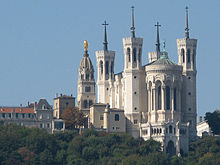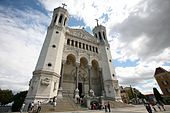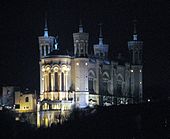- Basilica of Notre-Dame de Fourvière
-
The Basilica of Notre-Dame de Fourvière is a minor basilica in Lyon. It was built with private funds between 1872 and 1884 in a dominating position in the city. One author makes the possibly questionable statement that: "The reaction to the communes of Paris and Lyon were triumphalist monuments, the Sacré-Coeur of Montmartre and the basilica of Fourvière, dominating both cities. These buildings were erected using private funds, as gigantic ex-votos, thanking God for the victory over the socialists and in expiation of the sins of modern France." (Bertrand Taithe, Citizenship and Wars: France in Turmoil, 1870-1871, chapter "Religious Identities and Citizenship" 2001:100).</ref> like the similarly inspired Basilique du Sacré-Cœur, Paris. Its design, by Pierre Bossan, draws from both Romanesque and Byzantine architecture, two non-Gothic models that were unusual choices at the time. It features fine mosaics, superb stained glass,[1] and a crypt of Saint Joseph. The basilica, which offers guided tours and contains a Museum of Sacred Art, receives 1.5 million visitors annually[2]
Bossan's first sketches for the basilica seem to date from 1846. At the time he was in Palermo.[3].
The site it occupies was once the Roman forum of Trajan, the forum vetus, thus its name. Perched on top of the Fourvière hill, the basilica looms impressively over the city of Lyon, where it can be seen from many vantage points; not unintentionally, the basilica of Fourvière has become a symbol of the city of Lyon. The basilica has four main towers, and a belltower. It is topped with a gilded statue of the Virgin Mary. At certain times, members of the public may access the basilica's north tower for a spectacular 180-degree view of Lyon and its suburbs.
 The apsidal end, with the belltower
The apsidal end, with the belltower
Fourvière actually contains two churches, one on top of the other. The upper sanctuary is very ornate, while the lower is a much simpler design. Fourvière is dedicated to the Virgin Mary, who saved the city of Lyon from a cholera endemic sweeping Europe in 1823. Each year in early December (December 8., day of the Immaculate Conception), Lyon thanks the Virgin for saving the city by lighting candles throughout the city, in what is called the Fête des Lumières or the Festival of Lights.
During the Franco-Prussian War, Prussian forces, having taken Paris, were progressing south towards Lyon. Their halt and retreat were attributed by the Church to the intercession of the Virgin Mary once more. Work on the triumphant basilica was begun in 1872 and finished in 1884. Finishing touches in the interior were not completed until 1964.
Since 1982 the antennas of Radio Fourvière, the predecessor of Radios chrétiennes francophones, have been located in the tower. Notre-Dame de Fourvière was included when the whole historic center of Lyon was listed as a UNESCO World Heritage Site in 1998.
The Choir of the Basilica
Les Petits Chanteurs de Saint-Marc, The Children Choir of Saint Mark, is the official choir of the Basilica. This choir is well known after the release of the film Les Choristes. Director of this choir is Monsieur Nicolas Porte.
Notes
- ^ The stained-glass window depicting Marshal Pétain that was installed during the Nazi occupation of Vichy France was removed after the war. (Marianne Mahn-Lot, reviewing Renée Bedarida, Les Catholiques dans la Guerre, 1939-1945 (Hachette) 1999, in Le Mouvement social, No. 206, Au Bonheur Des Allemands Consommateurs et consommation au XXe siècle [January - March 2004:146-148] p. 147.
- ^ Fourvière Basilica
- ^ Bibliothèque municipale de Lyon
See also
5th arrondissement of Lyon Quarters Champvert · Fourvière · Le Point du Jour · Ménival · Saint-Georges · Saint-Irénée · Saint-Jean · Saint-Just · Saint-Paul · Vieux LyonStreets Squares Place Benoît-Crépu · Place de la TrinitéChurches Basilica of Notre-Dame de Fourvière · Église Saint-Georges · Église Saint-Paul · Lyon Cathedral · Temple du ChangeOthers monuments or structures Ancient Theatre of Fourvière · Cemetery of Loyasse · Gallo-Roman Museum of Lyon · Maison du Chamarier · Manécanterie · Metallic tower of Fourvière · Musée Gadagne · Odeon of Lyon · Palais de justice historique de Lyon · Taurobolic AltarTransports Funiculars of Lyon · Gare de Lyon-Saint-Paul · Lyon Metro Line D · Tram-train de l'ouest lyonnais · Velo'vCategories:- 5th arrondissement of Lyon
- Churches in Lyon
- Basilica churches in France
- World Heritage Sites in France
Wikimedia Foundation. 2010.



